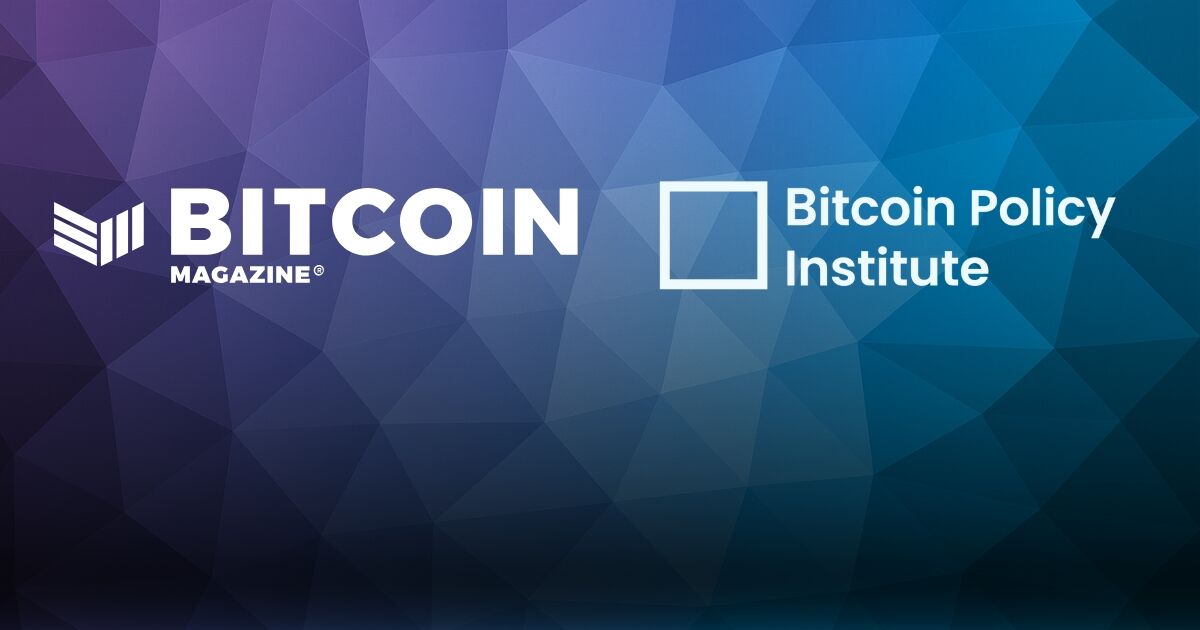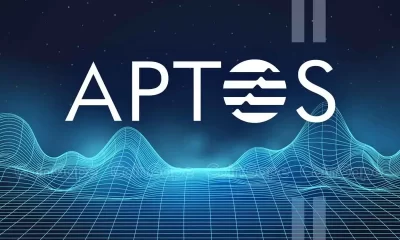Featured
Bitcoin Magazine, Bitcoin Policy Institute Launch “The Bitcoin Policy Hour” To Explore Global Finance, Policy And Monetary Trends
Published
3 weeks agoon
By
admin

New Show Release – “The Bitcoin Policy Hour”
April 9, 2025 – Nashville, TN – Bitcoin Magazine, in collaboration with the Bitcoin Policy Institute (BPI), has officially launched a new weekly show titled The Bitcoin Policy Hour, a timely and incisive series focused on political economy, macroeconomic policy, and the evolving global financial order.
The weekly show features BPI Executive Director Matthew Pines, Head of Policy Zack Shapiro, and Growth Associate Zack Cohen. With decades of combined experience in national security, regulatory affairs, and economic research, this trio brings a fresh and rigorous perspective to Bitcoin’s role in shaping the future of finance.
“The Bitcoin Policy Hour” aims to provide viewers with context-rich, forward-looking discussions that cut through the noise. Each episode dives deep into major developments in geopolitics, economic policy, trade, inflation, and sovereign debt—analyzing how these forces are reshaping the monetary landscape and what that means for Bitcoin.
The premiere episode, titled “Wargaming the Mar-a-Lago Accord: Tariffs, Bitcoin and Stablecoins”, explores the strategic implications of U.S.–China trade tensions, the emerging risks (and tailwinds) to the dollar system, and the potential realignment of global capital flows. Viewers are taken inside a scenario planning framework that considers how tariffs, national debt, and monetary experimentation are accelerating interest in non-sovereign monetary alternatives.
This new collaboration underscores the shared mission of Bitcoin Magazine and BPI to elevate public understanding of monetary policy and foster informed debate about the future of money.
Episodes of The Bitcoin Policy Hour will air weekly across Bitcoin Magazine’s media platforms, including YouTube, X, Rumble and BitcoinMagazine.com, providing an essential briefing for investors, policymakers, and anyone tracking the shifting tides of the global economy.
Source link
You may like


From Booze to Barbells: Exercise May Offset Risks of College Partying


Ethereum Foundation shuffles leadership, splits board and management


Bitcoin Price (BTC) Retakes $95K Level After Early U.S. Decline


A New Risk For The Industry?


Justin Sun Bets Big On JUST Token, Sees 100x Potential


Worldcoin price prediction | What’s next for WLD price?
business
The Emerging Market For State Services Via Citizen X
Published
10 hours agoon
April 28, 2025By
admin
Accelerating the Sovereign Individual thesis, Citizen X is opening new doors for passport diversification focused on Bitcoiners with the recent acquisition of Plan B Passport.
Citizen X, the tech-savvy Citizenship by Investment (CBI) company based in Switzerland, made a big splash this week with news of its merger with Plan B Passport, Katie “The Russian” Ananina’s Bitcoin focused CBI company.
“They’re insanely into privacy and security,” said Katie about the company, explaining the ways in which this merger super charges both companies and can accelerate the “Sovereign individual movement.”
The Sovereign Individual, a book initially published in 1997, has quickly become a staple of Bitcoin culture, with a proliferation of the word ‘Sovereign’ in brands and memes all throughout the industry.
The book posits a future where political power begins to decentralize from nation-states and legacy institutions to individuals, thanks to the economic forces unlocked by the internet and accelerating advancements in technology, like digital cash.
According to the book, growing trends in technology that favor individuals will increasingly persuade governments to compete for high-value talent, reframing the relationship between citizens and governments into a consumer-to-service-provider relationship. A market for state services and citizenships would become the norm as the entrepreneurs and wealth creators become increasingly agile, international and difficult to tax.
The idea of the sovereign individual and the many predictions made in the book about how the digital age will play out has inspired many entrepreneurs and technologists, including Katie and Alex Recouso, the CEO of CitizenX. Since the book’s publication believers in the sovereign individual thesis have been positioning to take advantage of this paradigm shift and some are even working to accelerate it.
Demand for a modern update to government processes intended to create more efficient state services appears to be a growing trend, with Elon Musk’s ‘Department Of Government Efficiency’ (DOGE) initiative blessed by Trump representing a recent example. The political structures and institutions that built the world many of us were born into are, arguably, in many cases outdated and increasingly obsoleted by technological advancements.
It is Katie’s personal frustrations with immigration bureaucracies throughout the world that lead her to start Plan B Passport. As a young star athlete and professional Russian sailor, she was denied visas and even got scammed by an immigration lawyer, forging her experience with immigration laws in both the US and Europe.
“I was denied European visas twice, an American visa once, and I was in a Russian national team. I was coming to Europe for the World Championship. How do you deny me a visa? I’m 15 years old, coming with my coach and the team, like, what’s the logic?” Katie recalled.
Katie was scammed by a US immigration lawyer, an event that challenged her to learn the system and laid the groundwork for the foundation of the company.
“That’s how it all started. I got to the US, paid $12,000 to an immigration attorney only to be ghosted. Literally. Basically, she just stopped responding to my emails and phone calls, and I had to self-represent,” she told Bitcoin Magazine.
Katie was soon after introduced to the Sovereign Individual Book.
“I obviously re-read the book way too many times, specifically the chapter on the end of nation-states,” Katie explained about the Sovereign Individual thesis. “The way they talk about it is that basically there will be a competition between nation-states for talent, the fruits of labor, and the capital. They naturally will compete by providing a better service at a better price, just like an actual capitalistic environment.”
“It’s accelerating right now,” she added. “Investment-based migration, that’s the way forward for governments now. That’s where you can dictate with your capital who you choose to benefit from your capital and the fruits of your labor. And you choose them according to the taxes, the lifestyle, the social environment, the freedom of speech, and all those good things.”
However, Bitcoiners have not had an easy time getting their wealth recognized or accepted in exchange for citizenship. Bureaucrats working at embassies often know little, and legal firms servicing this market need to do serious due diligence, often requiring proof of funds and expecting bank statements. But for the longest time, Bitcoiner companies have been unable to get bank accounts and Bitcoiners have had accounts closed when suspected of trading Bitcoin or crypto.
Throughout most of Bitcoin’s history, banks and governments not only ignored the digital asset and its entrepreneurs (with a few exceptions), but actually avoided relationships with the industry, in part due to political pressure from policy programs like Operation Choke Point.
Indeed, Bitcoiners were so underbanked that, for example, Tether, the biggest stablecoin in the digital currency market, was invented to give the industry a way to hedge and trade into dollar value, given that access to the banking system was rarely a good option.
This lack of recognition by legacy systems created a gap in the market that Katie identified: “I know Bitcoiners’ pain points better than anybody in the industry. I know Bitcoin itself better than anybody in the Citizenship by Investment (CBI) industry, and I could provide Bitcoiners with solutions that others couldn’t,” she told Bitcoin Magazine.
“All those countries that provide citizenship by investment,” she explained, “they have very thorough due diligence. So they want to see the source of funds. Bitcoiners come to any other CBI player who is a dude in a suit in his law office and say, ‘Hey, I mined bitcoin,’ or ‘I bought bitcoin in MtGox. It’s been in self-custody ever since. How do I prove it?’”
“They’ll be like, Mt-what?” she chuckled. “They will have no idea how to prove the source of funds. Obviously, they just want to see a financial institution statement.”
But Bitcoiners often have no such financial statements, and obtaining them could require the sale of significant amounts of bitcoin, triggering a tax event in many countries that could drastically increase the costs involved, deterring Bitcoiners from these CBI programs.
To make matters worse, the privacy risks faced by Bitcoiners are different from those in legacy finance. Bitcoin is not reversible, after all. Theft and extortion of bitcoin often leads to year long investigations that rarely yield results or recovered funds. The security of bitcoin value is thus best preserved at the current time by not being an obvious easy target in the first place, and that means preserving your privacy and minimizing the amount of people who know you have bitcoin at all or how much.
This is very different than the fiat system where having a few bankers or lawyers know your bank account balance as they fax it to each other in plain text is not great, but not a critical threat either. Transactions can generally be reversed and in a worst-case scenario, refunds can be printed out of thin air by their fraud risk departments to cover user loss.
Because of Bitcoin’s transparency, your Bitcoin wealth can be revealed to relative strangers, which can trigger people’s envy and, in the worst cases, even lead to cybersecurity threats or physical attacks in attempts to steal and extort funds.
To address these risks and the knowledge gap between Bitcoiners, the CBI industry, and the relevant government institutions, Plan B Passport built relationships with citizenship units: government officials in jurisdictions with CIB programs. Plan B also launched an innovative program that unlocked a more secure path to satisfy the proof of funds standards for Bitcoiners.
Such users would simply have to sign a message with the corresponding private keys to a Bitcoin public address, demonstrating in an off-chain, cryptographically provable way that they own the coins on that address. CheckMSG.org is an example of such technology. The cryptographic proof would then be reviewed and co-signed by a competent institutional partner, a US or Swiss firm, and a financial statement would be issued that Citizenship Units at the specific jurisdictions can work with.
“Originally, they were a little concerned about this whole thing,” she recalled about initial reactions to the program. “If we talk about four or five years ago, they would say, ‘Well, sell it into fiat and show it to us.’ Okay, whatever. But now, just like in the Sovereign Individual thesis—they realize, ‘There’s a lot of Bitcoiners who want passports, and we better serve them because that’s our money, that’s our bread.’”
The benefits of having a sophisticated technological approach in an industry that is otherwise very traditional in its tooling, differentiate CitizenX and Plan B Passport from their competitors. The merger could elevate the quality of CBI options available to Bitcoiners and empower Katie to open new markets and launch policy education initiatives in countries that might not know how to service this market.
“And honestly, that’s one of the motivations behind this acquisition. The whole sovereign individual movement, I feel like I had to really say no to quite a few opportunities that I knew could potentially result in accelerating this movement, simply because I was a sole founder, managing the processing department, managing the sales, right? All that stuff. And I felt like I just don’t have enough time and enough resources, enough talent to go and build out these other programs in the world that I know Bitcoiners would want to see,” Katie explained.
“So I had to pass on these opportunities. And through this acquisition, I think we get into the space, into the state where we can truly launch those new immigration initiatives and lobby for them in different jurisdictions, just so those small nations can get into the game, realize what they have to offer, realize what their market price is, and how they can benefit from launching a citizenship or residency by investment program, and I want to be there to help them do that,” she concluded.
Source link

In the beginning of April at the MIT Bitcoin Expo I was able to sit down with Jameson Lopp to discuss the current state of and future of Bitcoin.
Jameson co-founded Casa, a multisig self-custody service, with Jeremy Welch in 2017 after a long stint as a software engineer at Bitgo, another multisig service based company. He has been involved in the Bitcoin space since 2012 as a software developer and independent researcher.
Lopp is famously known for a swatting incident in 2017 during the blocksize wars, where someone attempted to have the police storm into his home under the mistaken belief that Jameson was holding hostages. After that incident he went completely off grid, changing his residence and living habits to ensure his name is not available anywhere in public record.
We discussed, very briefly, address poisoning attacks. After that subject, we had a broad discussion about the current state of Bitcoin development and Bitcoin itself as a protocol and project, including what is needed for its success in the long term.
Watch the interview here:
Source link

Bitcoin mining has come a long way since the days of GPUs and basement set ups. In that time, miners have advanced in countless ways. For example, ASICs are now the standard, not GPUs. Furthermore, enterprise grade players have entered the field, opening new frontiers and bringing with them the size and institutional recognition that opens the doors to otherwise unreachable places for smaller miners. Nowadays, the mining landscape is one where grid services, curtailment strategies, and energy market participation are no longer edge cases but core strategies. As the world around it has moved forward, there’s one question we keep hearing from miners: can PPLNS adapt?
Many miners, particularly those working closely with energy providers or integrating Demand Response mechanisms, have come to view PPLNS with suspicion. They worry that it penalizes downtime and rewards only uninterrupted hashrate—a bad deal for those who routinely curtail machines to support the grid or provide other services.
This fear isn’t baseless. It traces back to a pivotal moment in the mining industry’s recent past, one that apparently sealed the deal for many on PPLNS style payouts: the fallout between RIOT and Braiins Pool.
At the time, Braiins was using the Score payout system. Designed in 2011 by Slush himself, Score was engineered to solve the problem of pool hopping—when miners would jump between pools to exploit reward systems. There’s also been a misconception that Score is a PPLNS style payment system, but as Rosenfeld’s bible on pool payout systems describes, Score and PPLNS are distinctly different payout methods. The main difference is how they account for shares, specifically, Score implemented a rolling window with exponential decay function, this effectively made the lookback window very short. On the other hand, PPLNS is a family of payout systems with various types of fixed length lookback windows.
As shown on this archived website of how Score worked, you can see that after 90 minutes your hashrate had no more presence on the pool. This means that the moment a miner starts mining, their share of rewards fairly quickly reaches the fair value of the hashrate. On the other hand, when a miner stops mining, it drops equally fast, as shown on the gif below.

This might have worked well in the era of cowboys and hackers, but it was never designed with today’s complex mining environments in mind. Certainly not with Demand Response, where miners intentionally and profitably take machines offline to stabilize energy grids or bid into ancillary markets. To Score, that kind of behavior looks no different than a pool hopper—someone attempting to cheat the system.
So when RIOT left Braiins, citing concerns about payout mechanics, it sent a shockwave through the mining world. Due to the aforementioned misconception, Score system’s flaws got unfairly projected onto a broader category of payouts, PPLNS got caught in the fray, catching a stray bullet in the process, and the industry collectively threw the baby out with the bathwater.
But the mining world has changed, and it’s time for the phoenix to rise from his ashes.
SLICE: A Payout Mechanism for the 21st Century Grid
Enter SLICE, a modern, open-source Stratum-V2-ready payout system created by the DMND team. It’s an improvement and evolution of PPLNS, that rethinks how miners get paid, rewards are calculated, and —most importantly— how downtime is treated respect
to Score. All while preserving miner’s right to build their own block templates with SV2.
At its core, SLICE is about fairness and transparency. It preserves the foundational idea of PPLNS—paying miners in proportion to their actual contribution to solving blocks—while modernizing it for today’s decentralized mining landscape.
The key innovation lies in how SLICE structures reward calculation, and on how the lookback window works. Rather than treating the entire pool as a monolith, SLICE breaks time into smaller, dynamic “slices” of work to properly distribute the fee component. These slices represent batches of shares submitted over a specific period, where we control for the amount of fees in the mempool, and compare and score different job templates for the financial value they represent. When a block is found, SLICE distributes the block subsidy and transaction fees separately. The subsidy is allocated proportionally by hashrate, while the fees are distributed based on hashrate and financial value.
This is particularly relevant in a world where miners can choose their own transaction sets. Some miners may prioritize high-fee MEV-style bundles; others may exclude certain types of transactions for ideological, political or technical reasons. SLICE ensures that, within each slice, miners are rewarded according to both the quantity and quality of their work—without punishing them for downtime or strategic energy decisions. For those curious to learn more, this article can prove helpful.
Demand Response Without Penalty
What makes SLICE especially attractive for miners participating in Demand Response or curtailment programs is that it doesn’t penalize you for being offline.
That’s because SLICE doesn’t decay your payout just because you took a break. Your shares remain in the PPLNS window—the rolling window of recent work that is eligible for payouts—as long as they’re recent enough. In this way, each share is treated independently, and is expected to get 8 payouts, since SLICE uses an 8-block rolling window, each valid share remains eligible for payout across the next 8 blocks on average. This means that regardless of how big or small the pool is, you will never have the abysmal luck of eating up bad luck days without a block, disconnecting, having the pool find a block, and not get paid.
That means miners can power down during peak demand hours, support their regional grid, and still collect their fair cut from blocks found after they resume operations, most importantly, even while they’re offline, if their shares are still in the window. In other words, if the pool has a streak of bad luck, and then the miner is called to perform demand response and shuts off, even if the pool finds a block during their down time, that miner will get paid their fair share for all the time they were online. That’s because each share generated during that time will be active and getting paid for 8 blocks on average.
This is not a workaround. This is the feature. It makes SLICE fully compatible with modern energy strategies that require flexibility, whether you’re participating in frequency regulation markets, ramping down during grid emergencies, or simply optimizing for off-peak pricing.
For example, let’s say that a miner is mining at a pool, and the pool hasn’t found that day’s block yet. This means that the pool hasn’t found the block yet, and thus the miners hasn’t gotten paid for that day yet. Now, the miner shuts off to provide ancillary services during peak summer load for a few hours, during that time, the pool finds the block. In a Score based pool, the miner would not see a single Sat of that after 90 minutes, when the decay has had full effect. But even if the pool found a block 30 minutes later, due to the exponential decay, the miner would barely see anything. On the other hand, the miner would have all of the shares they mined over the day receive a payment, since each share receives on average 8 payments. Thus, the miner would benefit in the good times, and not be penalized in the bad times.
Payment Transparency and Auditability
Furthermore, SLICE doesn’t just modernize payout fairness—it does so in a way that minimizes trust in the pool operator. Every slice is fully auditable. Each share is tracked, indexed, and publicly verifiable by any miner, so miners can independently verify their share of the block reward. There’s no black box, no “trust me bro.”
And if the pool operator attempts to cheat—say, by injecting fake shares to dilute payouts—miners can challenge the integrity of the slice. The Job Declaration extension to Stratum V2, which SLICE relies on, includes mechanisms for publishing share data, verifying Merkle roots, and ensuring that each share corresponds to real computational work.
For miners who care about decentralization, SLICE isn’t just a payment scheme—it’s an accountability tool.
From Defensive to Strategic
The shift from Score to SLICE represents more than a technical upgrade. It’s a mental shift. Mining pools no longer need to defend against bad actors by penalizing everyone. Instead, they can structure payouts in a way that reflects reality: that miners are sophisticated participants working not only in the Bitcoin blockchain, but also the energy ecosystem.
With SLICE, PPLNS stops being a liability and becomes a strategic advantage. It enables better revenue capture, more transparency and auditability, and smoother integration with grid services.
And in a world where uptime is optional, but fairness is non-negotiable, that’s exactly what enterprise-grade miners need, a strategic pool partner that pushes forward and innovates, bringing the future today and enabling miners to make more money with the same hardware.
This is a guest post by General Kenobi. Opinions expressed are entirely their own and do not necessarily reflect those of BTC Inc or Bitcoin Magazine.
Source link

From Booze to Barbells: Exercise May Offset Risks of College Partying

Ethereum Foundation shuffles leadership, splits board and management

Bitcoin Price (BTC) Retakes $95K Level After Early U.S. Decline

A New Risk For The Industry?

Justin Sun Bets Big On JUST Token, Sees 100x Potential

Worldcoin price prediction | What’s next for WLD price?

Bitcoin Is About To Begin Outperforming Gold, Says InvestAnswers – Here’s His Timeline

Bloomberg Analyst Confirms No Set Launch Date for ProShares XRP ETFs

What is Base? The Ethereum Layer-2 Network Launched by Coinbase

Loopscale hacker in talks to return stolen crypto

Bitcoin (BTC) Yield Platform Coming From Coinbase (COIN), Aspen Digital

The Emerging Market For State Services Via Citizen X

XRP Price Shoots For 20% Surge To $2.51 Amid Pullback To Breakout Zone

Stocks edge higher ahead of big earnings week

Here’s How Bitcoin Could Boost Demand for US Treasuries, According to Macro Guru Luke Gromen

Arthur Hayes, Murad’s Prediction For Meme Coins, AI & DeFi Coins For 2025

Expert Sees Bitcoin Dipping To $50K While Bullish Signs Persist

3 Voting Polls Show Why Ripple’s XRP Price Could Hit $10 Soon

Aptos Leverages Chainlink To Enhance Scalability and Data Access

Bitcoin Could Rally to $80,000 on the Eve of US Elections

Crypto’s Big Trump Gamble Is Risky

The Future of Bitcoin: Scaling, Institutional Adoption, and Strategic Reserves with Rich Rines

Institutional Investors Go All In on Crypto as 57% Plan to Boost Allocations as Bull Run Heats Up, Sygnum Survey Reveals

Sonic Now ‘Golden Standard’ of Layer-2s After Scaling Transactions to 16,000+ per Second, Says Andre Cronje

Ripple-SEC Case Ends, But These 3 Rivals Could Jump 500x

Has The Bitcoin Price Already Peaked?

A16z-backed Espresso announces mainnet launch of core product

Xmas Altcoin Rally Insights by BNM Agent I

Blockchain groups challenge new broker reporting rule

I’m Grateful for Trump’s Embrace of Bitcoin
Trending

 24/7 Cryptocurrency News6 months ago
24/7 Cryptocurrency News6 months agoArthur Hayes, Murad’s Prediction For Meme Coins, AI & DeFi Coins For 2025

 Bitcoin3 months ago
Bitcoin3 months agoExpert Sees Bitcoin Dipping To $50K While Bullish Signs Persist

 Ripple Price1 month ago
Ripple Price1 month ago3 Voting Polls Show Why Ripple’s XRP Price Could Hit $10 Soon

 24/7 Cryptocurrency News4 months ago
24/7 Cryptocurrency News4 months agoAptos Leverages Chainlink To Enhance Scalability and Data Access

 Bitcoin6 months ago
Bitcoin6 months agoBitcoin Could Rally to $80,000 on the Eve of US Elections

 Opinion6 months ago
Opinion6 months agoCrypto’s Big Trump Gamble Is Risky

 Bitcoin3 months ago
Bitcoin3 months agoThe Future of Bitcoin: Scaling, Institutional Adoption, and Strategic Reserves with Rich Rines

 Bitcoin6 months ago
Bitcoin6 months agoInstitutional Investors Go All In on Crypto as 57% Plan to Boost Allocations as Bull Run Heats Up, Sygnum Survey Reveals


